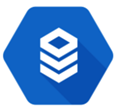Cloud SQL is a fully managed relational database service for PostgreSQL and MySQL in the cloud. Cloud SQL offers many features for both MySQL and PostgreSQL databases. With cloud SQL, you can deploy large instances of your MySQL databases. These instances support MySQL 5.6 or 5.7 and up to 416 GB of RAM and 10 TB of storage space. Google also automatically encrypts all customer data on these database instances. The encryption also extends to Google's internal networks and temporary files. Cloud SQL also offers data replication across multiple zones and instances. This logo represents Google Cloud SQL:

Cloud SQL offers similar features for its PostgreSQL databases. As of this writing, PostgreSQL version 9.6 is supported with machines of up to 416 GB of RAM, 32 CPUs, and 10 TB of storage space, with room to grow in the future.
When a cloud SQL instance is...



